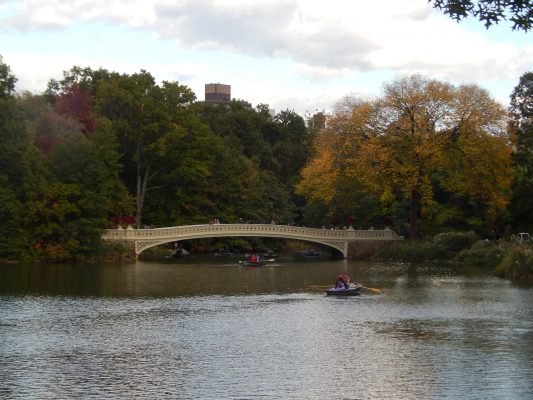Strollin’ Through Central Park
Central Park is the perfect getaway from the hectic buzz of the city, and it’s only blocks away from Fordham’s campus. (COURTESY OF LYDIA BENNER)
October 12, 2017
Living in the Big Apple often inspires a craving for adventure. New York is our campus, and Central Park is a slightly enlarged version (843 acres) of the plaza at Fordham Lincoln Center. Central Park, also nicknamed the lungs of Manhattan, is the most visited urban park in the United States and, luckily for all Fordham students, it is only a few blocks away from school. The Park is visually breathtaking during the month of October, and experiencing nature can help de-stress from midterms.
So, without further ado, here is your ultimate guide to Central Park:
When entering the Park on 64th Street, the feeling of stepping into a new world is inevitable. You are instantly exposed to a plethora of runners, walkers and dog walkers, all exercising on West Drive. But try to not get too distracted, as you don’t want to get run over by the romantic and flamboyant horse carriages that are strolling down the runway.
As you walk north among the runners, you will inevitably see the enormous field of Sheep Meadow. Filled with sunbathers enjoying the warmth on a Sunday afternoon and families relishing their delicious picnic baskets, Sheep Meadow is a must-see.
Strawberry Fields, located northwest of the meadow, offers great shade and intimacy. It is best known for its memorial to John Lennon, who was shot outside his home at the nearby Dakota Apartments. Also considered a “peace garden,” Strawberry Fields pays further tribute to Lennon with a black-and-white mosaic in which the words “Imagine” are engraved, often surrounded by flowers. The mosaic is a reference to John Lennon’s best-selling single, a true classic that inspires hope. The landscape itself is named after his song “Strawberry Fields Forever.”
When you turn right from Strawberry Fields and stroll across Terrace Drive, you’ll see the grand Cherry Hill Fountain. A common misconception is that this fountain is the one from the opening credits in “Friends;” that fountain is in fact modeled after the Brewer fountain in Boston. The Cherry Hill Fountain was built in the 19th century as a watering trough for horses, although they are no longer allowed to drink from it.
It is now time to explore one of Central Park’s hidden gems: The Ramble. To get there, you have to cross through Bow Bridge, where you can see a multitude of rowboats twirling on The Lake. The Ramble may at first seem like a messy zigzag, but this maze offers one of the best experiences when encountering animals. The Ramble is most famous for its birdwatching opportunities; however, you will most definitely see several squirrels hopping around the shrubs.
As you leave The Ramble, you will see the majestic Belvedere Castle, whose name translates to “beautiful view” in Italian. Indeed, it truly does offer great views over the Great Lawn and the Turtle Pond. Similar to Sheep Meadow, the Great Lawn is a massive field where New Yorkers play sports and enjoy great food. In addition, the Belvedere Castle’s balconies provide unforgettable views of the Manhattan skyline. Ever since 1919, the Belvedere Castle has been used to record temperature and precipitation measurements. You can see the instruments used to measure wind on top of the castle’s turret.
Turning left from the Belvedere Castle, you will soon enter one of the places less frequently visited by tourists in Central Park―Shakespeare Garden. It is a great spot for photo ops, but is also a truly peaceful area where you can study! Surrounded by beautiful flowers, all the plants in the garden are references to many of Shakespeare’s plays, such as the rosemaries and pansies in “Hamlet” and the thistles in “Much Ado about Nothing.” The bronze plaques, placed in front of every specific plant, have matching quotations from the plays. The romantic garden also has a white mulberry tree that had been grafted from Shakespeare’s very own garden in Stratford-upon-Avon.
It is now time to head back. Feel free to grab a well-deserved warm waffle from the Wafels & Dinges stand on the Great Lawn Oval; you have earned it! As you walk towards the East Drive, you will see the great Polish King Jagiello statue, holding the two swords that are a symbol of the union of Poland and Lithuania in the 15th century.
Walking down the East Drive, you will also come across the Conservatory Water. It is a special and unforgettable sight, as this model boat pond was inspired by those in Paris in the 19th century. The Conservatory Water is also used as a free ice skating rink in the winter, so make sure to check it out in the colder months!
After taking endless amounts of snapshots and pictures, make sure to see the most memorable spot in Central Park: the Bethesda Fountain. Most of you will recognize the stunning Bethesda Terrace from the iconic scene in the “Gossip Girl” series. Regardless of how you recognize it, the Bethesda Fountain, one of New York’s largest fountains, is truly breathtaking.
The large bronze sculpture, also known as the Angel of Waters, commemorates the opening of the Croton Aqueduct in the 19th century, as it supplied the city with drinking water in times where the scarcity of fresh and clean water was strikingly high. The Angel of Waters stands above four cherubs that symbolize purity, health, peace and temperance. Furthermore, the angel is holding a lily in its right hand, symbolizing purity, and is represented blessing the water in the fountain with its left hand. Lastly, the romantic Bethesda Fountain in the Terrace is also a popular area for wedding photo shoots as it is truly beautiful scenery.
Going to Central Park and seeing all of these magnificent landmarks will most likely spark a sense of appreciation for nature, and make you even more grateful to live in New York City!











